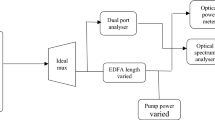Abstract
Free space optics (FSO), going to replace the present microwave communications in the future is gaining considerable attention as it supplies fruitful solutions to many complications like the last mile problem. Besides availing many advantages like high bandwidth, data rate, low bit error rate any communication system operating in free space undergoes a significant amount of degradation in its signal strength due to the atmospheric affects in its pathway. Similarly, an optical signal launched into free space will also interfere with its surroundings and may get impaired due to the presence of different climatic conditions like rain, fog, haze, snow, gas molecules etc. As FSO is a perfect line of sight communication it may also undergo the problems of outage due to obstructions (birds, base motion), scattering, beam dispersion etc. Precise prediction of the impairments (atmospheric affects) can result in an efficient and flawless communication system. Supporting the research on free space optics this paper mainly focuses on the performance analysis of free space optical link in the presence of rain considering the parameters like received optical power its corresponding electrical power, quality factor. The analysis was extracted with the help of simulation using Opti System software developed by Optiwave.






Similar content being viewed by others
References
Al-Gailani, S. A., Mohammad, A. B., & Sheikh, U. U. (2014). Determination of rain attenuation parameters for free space optical link in tropical rain. Optik, 125(4), 1575–1578.
Bloom, S., Korevaar, E., Schuster, J., & Willebrand, H. (2003). Understanding the performance of free-space optics. Journal of Optical Networking, 2(6), 178–200.
Al-Gailani, S. A., Mohammad, A. B., & Shaddad, R. Q. (2013). Enhancement of free space optical link in heavy rain attenuation using multiple beam concept. Optik, 124(21), 4798–4801.
https://www.nasa.gov/directorates/heo/scan/engineering/technology/index.html. Accessed 12 Jan 2017.
Immadi, G., Kotamraju, S. K., Venkata Narayana, M., Rajkamal, K., Khan, H., Viswanath, G., & Avinash, I. (2015). Measurement of rain attenuation for KU band satellite in tropical environment using DAH, SAM models. ARPN Journal of Engineering and Applied Sciences, 10(4), 1717–1722.
Sharma, P., & Sarangal, H. (2016) Performance comparison of APD and PIN photodiodes using different modulation and different wavelengths. International Journal of Signal Processing, Image Processing and Pattern Recognition, 9(4), 257–264, 2005-4254.
Noor, N. H. M., Naji, A. W., & Al-Khateeb, W. (2012). Performance analysis of a free space optics link with multiple transmitters/receivers. IIUM Engineering Journal, 13(1), 49–58.
Sharma, P., & Sarangal, H. (2015). Performance evaluation of multiple transceiver FSO for different weather conditions. International Journal of Signal Processing, Image Processing and Pattern Recognition, 8(12), 149–156, 2005-4254.
Nor, N. A. M., Islam, M. R., & Al-Khateeb, W. (2013). Atmospheric effects on free space earth-to-satellite optical link in tropical climate. International Journal of Computer Science, Engineering and Applications (IJCSEA), 3(1), 17–36. https://doi.org/10.5121/ijcsea.2013.3102.
Suriza, A. Z., Islam, M. R., Al-Khateeb, W., & Naji, A. W. (2011). Analysis of rain effects on terrestrial free space optics based on data measured in tropical climate. IIUM Engineering Journal, 12(5).
Immadi, G., Kotamraju, S. K., Khan, H., Venkata Narayana, M., Hemavasavi, K., Naga Sai, K. P., & Sirisha, N. (2014). Estimation of Ku band satellite signal propagation impairment due to rain in tropical environment using ITU-R. International Journal of Applied Engineering Research, 9(20), 7149–7168.
Basahel, A. Islam, M. R., Habaebi, M. H., & Suriza, A. Z. (2015). A proposed rain attenuation prediction method for free space optical link based on rain rate statistics. ARPN Journal of Engineering and Applied Sciences, 10(23), 17351–17355.
Author information
Authors and Affiliations
Corresponding author
Additional information
Publisher's Note
Springer Nature remains neutral with regard to jurisdictional claims in published maps and institutional affiliations.
Rights and permissions
About this article
Cite this article
Immadi, G., Venkata Narayana, M., Kotamraju, S.K. et al. Estimating the Performance of Free Space Optical Link Under Adverse Weather Conditions by Using Various Models. Wireless Pers Commun 103, 1603–1613 (2018). https://doi.org/10.1007/s11277-018-5870-7
Published:
Issue Date:
DOI: https://doi.org/10.1007/s11277-018-5870-7




